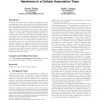Free Online Productivity Tools
i2Speak
i2Symbol
i2OCR
iTex2Img
iWeb2Print
iWeb2Shot
i2Type
iPdf2Split
iPdf2Merge
i2Bopomofo
i2Arabic
i2Style
i2Image
i2PDF
iLatex2Rtf
Sci2ools
MOBICOM
2015
ACM
2015
ACM
Deriving Cellular Network Structure from Inferred Handovers in a Cellular Association Trace
A cellular association trace consists of timestamped events recording user activity in labeled cells in a cellular network. From such data one can infer that if a user appears in two different cells within a short span of time, that a handover took place, and that the coverage areas of the two cells overlap. That is, one can infer geographic information from handover behavior. One would like to expand this kind of inference to a larger scale, perhaps reconstructing a proximity graph of the cellular sites, or creating an approximate 2-dimensional embedding of the cells. We have analyzed a large-scale cellular association trace of several months of activity for several million users on a 3G network, and have found that handover behavior is actually incredibly diverse and complicated, making it very difficult to make any sort of global inferences, even in small sections of a network. In this paper we present some stable elements of handover behavior, and present several methods one can u...
| Added | 14 Apr 2016 |
| Updated | 14 Apr 2016 |
| Type | Journal |
| Year | 2015 |
| Where | MOBICOM |
| Authors | Brenton Walker, Anders Lindgren |
Comments (0)

